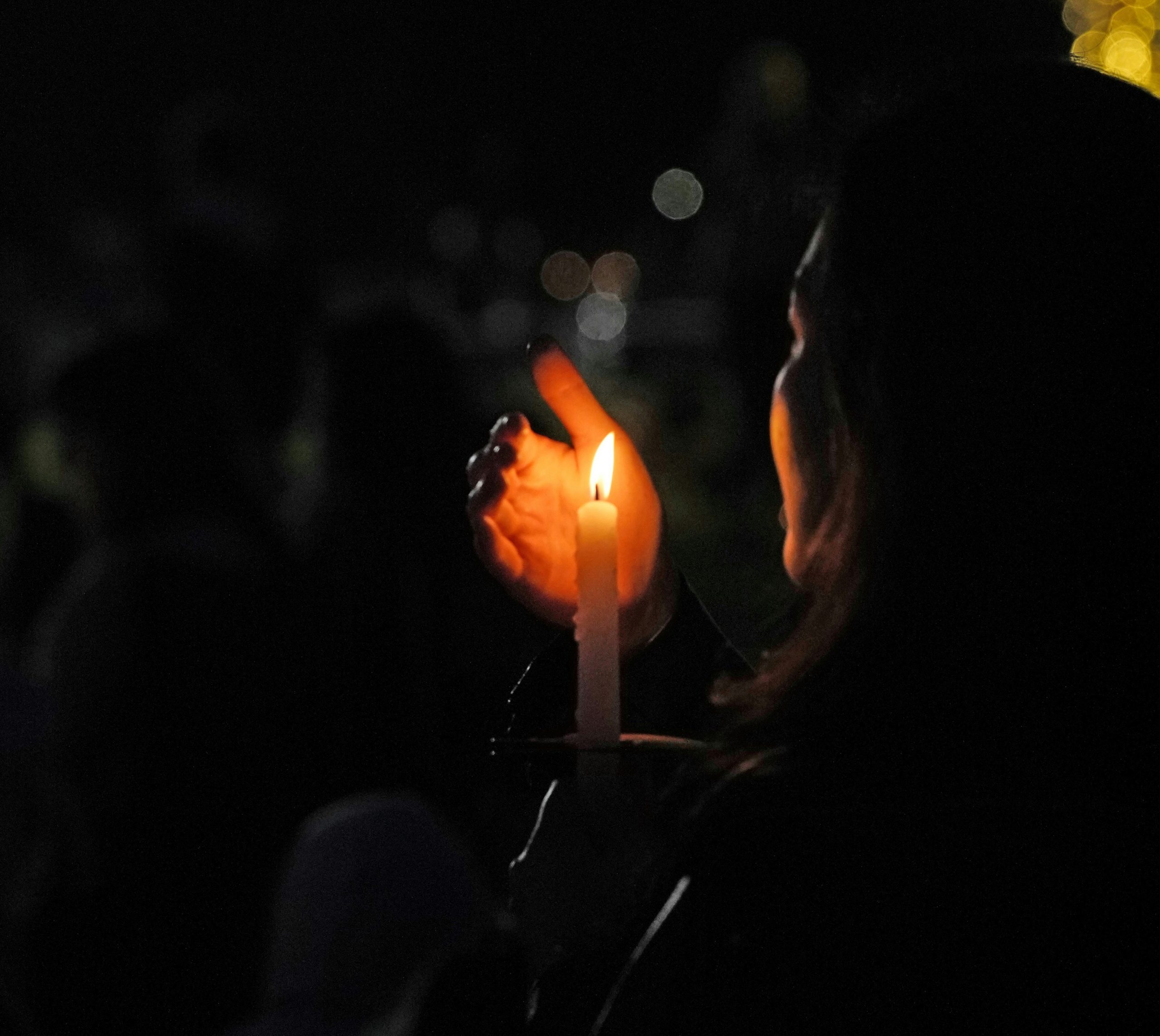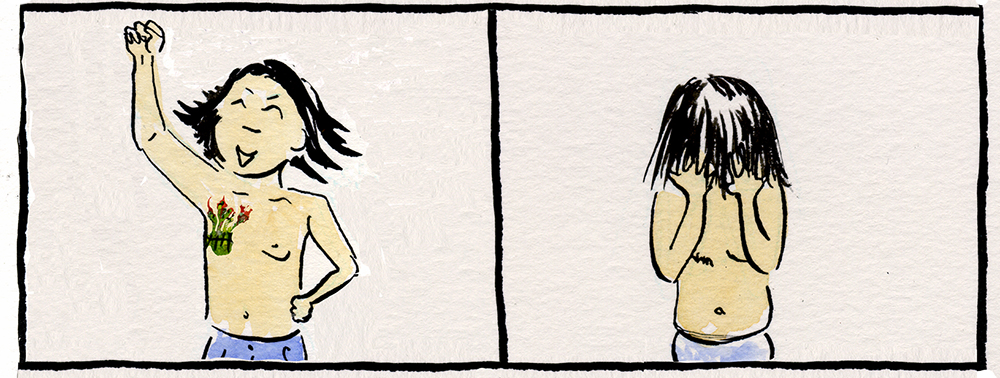Books & Culture
Grief Memoirs Are for the Living
Survivors of other people’s suicides carve out a public space for practicing grief

I learned about suicide in real time, like discovering the existence of airtravel by spotting a jet arcing across the sky. The thirteen-year-old was dead, but how? In her own bedroom, covered in pink and posters? You said she did it by herself? On purpose? I was a few grades below her, and barely capable of boiling pasta alone.
I tried to enter her mind in the days before, and then in the moments before. How she had prepared to face her own death, as across town my sister and I prepared to face math worksheets and a mandatory bedtime. I tried to enter her parents’ minds, too. What could their conversations be—what dialogue can you speak in a house that has become a crime scene? Among my peers, the story of the girl’s death became a grisly mystery whose strangeness was unfolded again and again, like a contraband book of scary stories.
The eleventh most common cause of death in the United States, suicides have the unsettling feeling of whodunits that arrive solved, but still invite obsessive puzzling. If we could only write down all the clues and signs, parse out the timeline, give language to our supreme devastation, we imagine, we might begin to make sense of things. Then formless grief might take the more comforting, familiar form of a book.
Sloane Crosley’s arch, elegiac new book Grief Is for People is the latest entry to a genre for which there is an endlessly, nightmarishly growing audience: books about surviving another person’s suicide. Grief is for People joins a bookshelf crowded with memoirs and non-fiction works about loss to suicide. In recent days: Molly by Blake Butler (2023), Sinkhole by Juliet Patterson (2022), Stepping Back from the Ledge by Laura Trujillo (2022), Certain and Impossible Events by Candace Jane Opper (2021), and Life After Suicide by Jennifer Ashton (2020). Clancy Martin’s How Not To Kill Yourself (2023) and Yiyun Li’s Where Reasons End (2019) concerned both the writers’ suicidality as well as the suicides of their family members. Anne Sexton’s daughter wrote a book about her mother’s suicide. So did Kurt Cobain’s cousin, and David Foster Wallace’s wife. “Doesn’t the blood of every suicide splash back on our faces?” asked David Sedaris, writing in 2013 about his sister’s suicide. After a suicide, I’ve seen communities announce the intent to “pull together,” and then all too quickly rush the bereft to move on, or “remember the good times.” These books pause time, stretching out the memorial or wake or shiva long beyond the hour final mourners would linger.
I come back again and again to these books about life after another person’s death, amazed by the precision with which they capture the sensations of grief.
I come back again and again to these books about life after another person’s death, amazed by the precision with which they capture the sensations of grief, the many ways they find to say accurately and exquisitely what has been said before and will be said again. “My friend was alone when he was murdered,” Crosley writes, then repeats the same line, as if eager to watch the ink seep into the page, to make a tangible record of horror, and step back to marvel at it. It reminds me of being a child, trying to understand a child’s suicide: alive, then dead. Here, then gone. Forever? Forever.
In claiming public attention for their specific pain, these writers carve out a public space for practicing grief. They disrupt the obliterating silence that has historically accompanied a suicide. Crosley, an essayist and novelist who has made a career of unsentimentality, devotes herself to full-throated mourning, and to making an accounting. Her book is a ledger of what has gone missing, and an argument for keeping talley. “If I do not capture what I have lost,” she writes, “it will be like losing it twice.”
Written in the immediate aftermath of the loss, Grief is for People records the thoughts and actions of a person who is almost willing herself to be haunted. “My initial grief, which I thought might be taking a manageable shape, has mutated,” Crosley reports, at the point when friends and acquaintances begin to tacitly demand that a grieving person move on or at least fake it. “It’s colonized my entire personality. Any word that comes out of my mouth that is not Russell’s name is a lie.” Russell is Russell Perreault, the executive director of publicity for Anchor Books. He was Crosley’s best friend, former boss, and father figure, and he killed himself in 2019.
A longtime humorist, Crosley turns as unsparing an eye on grief as she has often trained on New York neighbors on dinner party drama. She captures the abortive moments of empathy, when onlookers try to relate to her grief through anecdotes about their ‘father’s law partner’s wife’ dying. “I have perfectly edible yogurt in my fridge, purchased before my best friend hanged himself, but do go on,” she snaps internally. (“There is no good language when it comes to the unspeakable,” Li writes in Where Reasons End.) As if daring the reader to chastise her, Crosley devotes nearly equal on-page real estate to a home invasion, one month before the suicide, which relieved her of all of her jewelry. “If I can get these items back, I can get my friend back,” she reasons. “I would sooner be separated from this logic than from my own skin.” Both events leave her unmoored, missing something precious, and laboring in the delusion that if she would only retrace her steps, everything might be put to right. Perreault, Crosley writes, “believed in the souls of objects.” He would have perfectly understood the intertwining of the two losses. Books written about a beloved person’s death are not strictly for readers—we trespass in the margins, peering into scenes of devastation. The ideal reader for this book is dead, these writers suggest. The reader is invited as an impossibly distant second place.
The cliches of grief feel belittling, as if another person’s death has parked you permanently in a high school counselor’s office.
“Judging whether life is or is not worth living,” wrote Camus, “amounts to answering the fundamental question of philosophy.” This is interesting in theory, but not relevant at 4AM when you’re going back through a newly dead person’s social media profile, looking for clues. In the wake of a suicide, the mind wanders away from the elegant logic of philosophy, and towards the truisms of Tumblr memes and suicide prevention slogans: You are not alone. You are loved. There is hope. The cliches of grief feel belittling, as if another person’s death has parked you permanently in a high school counselor’s office.
Books about another person’s suicide veer away from politeness into the realm of nightmare, resurrection attempts, and magical thinking. There is great comfort in reading descriptions of a grieving person crawling up the walls of her own addled, grieving mind. Carla Fine, the author of No Time to Say Goodbye: Surviving the Suicide of a Loved One, tortured herself with thoughts that she might have been able to prevent her husband’s death if only she had “been more insistent about our going out to dinner together the night before.” Trujillo’s book opens with the author gazing down at the spot where her mother fell to her death. Li’s narrator, in the space of three pages, references Flaubert, offers the Latin root for the word “stupid,” and recites lyrics from Andrew Lloyd Webber’s Phantom of the Opera: “Wishing you were somehow here again, wishing you were somehow near.” In life, our experiences of other people’s grief are often limited to tributes: an anguished Instagram caption, a glimpse of a tattooed date under a rolled-up shirtsleeve. In memoirs, the oddness of grief and the unpalatable behavior of the bereaved become the reader’s business.
When Carla Fine’s husband killed himself in 1989, she told all but her closest loved ones that he died of a heart attack. The shame was too enormous. She mourned in solitude.
“I did not have the stomach to face their real or imagined accusations, blaming me—or blaming him—for his death,” she later wrote in her book No Time to Say Goodbye: Surviving the Suicide of a Loved One.
A month later, she ventured into basement support group for people grieving suicides. But she balked—before even taking off her coat, she was stealing from the room, wanting to get away from the odd and unidentifiable expressions of other people’s grief. A man, the group’s facilitator, approached her as she made to leave.
“Please stay here with us,” he said. “You’re among friends.”
I’m moved by the profusion of suicide memoirs, even as I feel panicked at rising suicide numbers.
To read these suicide memoirs is to feel yourself to be among friends. The writers are people who are not quite on the side of the living. They articulate the sweet, sickening nature of mourning, the wild attempt of a living person to claw under the dirt with the dead. Crosley narrates for the reader how her friend’s death becomes more real to her than her own life. “I have the strongest sensation that if I only knew where to push, I could reach through and pull him back,” she writes. “By living, I am, by default, leaving him.” She offers a stunning image of cradling herself in her grief like a child. Taken by the mournful sound of a singer’s voice, she writes, “I imagine this moment holding me up on its hip, bouncing me. Wave goodbye to Russell! Say: Bye-bye, Russell!” In the book’s final pages Crosley speaks directly to Perreault, as she commits going forward in a life without him. “I know you,” she reminds him. The reader knows him a little, too. The moment bounces us on its hip: we sit with Crosley, waving goodbye.
What can books written by people grieving loss from suicide do for us? They revive the dead in the brief space between the front and back cover. They let us sit with a stranger’s familiar grief for a while. We are invited to an open-casket viewing of the writer’s most vulnerable feelings, so that we may recognize our own mourning, or save the image as a roadmap for a future grief.
What I remember now about the suicide of the little girl was the silence that accompanied it. It felt like a hand had been clasped over the community’s mouth. Surely, people did not wish to reproduce stupid platitudes about dying—“She’s in a better place!”—or to cheapen the moment with gossip. But I think just as likely the parents of the community were experiencing a sense, itself child-like, that to acknowledge a suicide too loudly would make it more real. Speaking about it would crack the door open and allow the specter of suicide to venture into your own home, to sidle up to your own children. Decades later, I’m moved by the profusion of suicide memoirs, even as I feel panicked at rising suicide numbers. These books take the opposite approach to the cold silence that often falls over a suicide—they pour words into the wound.
In Miriam Toews’ 2015 All My Puny Sorrows, a novel written in the wake of Toews’ sister’s death from suicide, the family works round-the-clock to keep Elfrieda, or Elfie, from killing herself. She is able to kill herself by convincing her husband to go to the library to get her some books.
“Well, Elf, I thought, you’re so clever,” her sister reflects. “Getting him to leave you alone on the pretext of getting books. Of going to the library. Of course he’d do it. Books are what save us. Books are what don’t save us.”
Books about another person’s suicide save us from going through it in silence.








